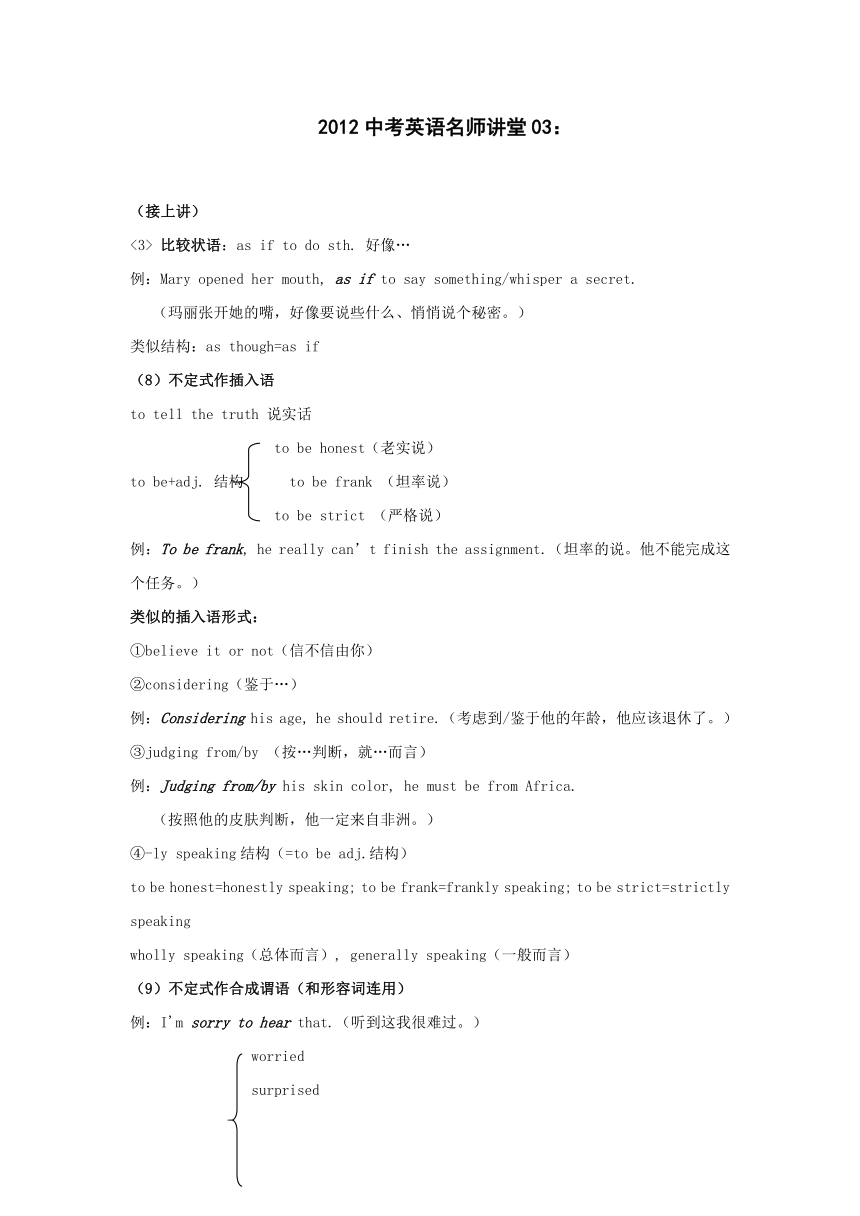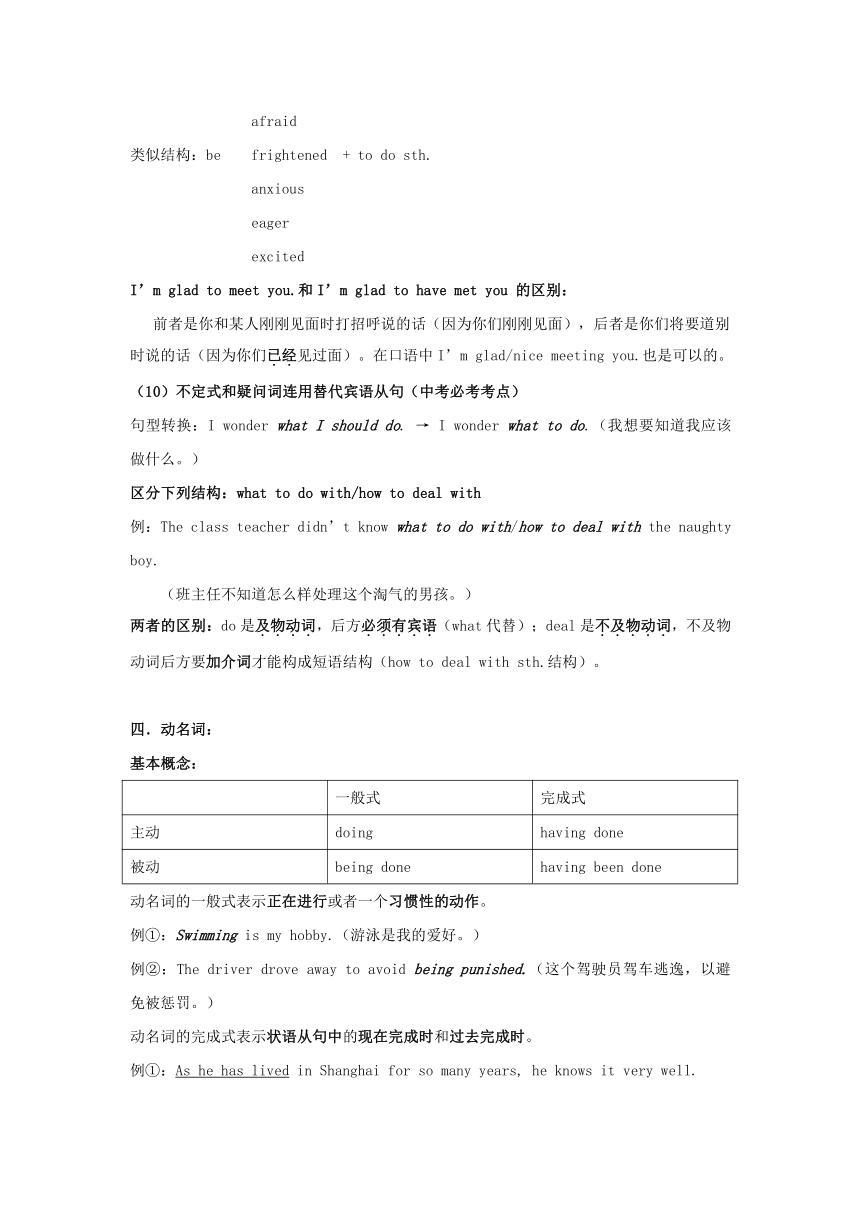2012中考英语名师讲堂03:
图片预览


文档简介
2012中考英语名师讲堂03:
(接上讲)
<3> 比较状语:as if to do sth. 好像…
例:Mary opened her mouth, as if to say something/whisper a secret.
(玛丽张开她的嘴,好像要说些什么、悄悄说个秘密。)
类似结构:as though=as if
(8)不定式作插入语
to tell the truth 说实话
to be honest(老实说)
to be+adj. 结构 to be frank (坦率说)
to be strict (严格说)
例:To be frank, he really can’t finish the assignment.(坦率的说。他不能完成这个任务。)
类似的插入语形式:
①believe it or not(信不信由你)
②considering(鉴于…)
例:Considering his age, he should retire.(考虑到/鉴于他的年龄,他应该退休了。)
③judging from/by (按…判断,就…而言)
例:Judging from/by his skin color, he must be from Africa.
(按照他的皮肤判断,他一定来自非洲。)
④-ly speaking结构(=to be adj.结构)
to be honest=honestly speaking; to be frank=frankly speaking; to be strict=strictly speaking
wholly speaking(总体而言), generally speaking(一般而言)
(9)不定式作合成谓语(和形容词连用)
例:I'm sorry to hear that.(听到这我很难过。)
worried
surprised
afraid
类似结构:be frightened + to do sth.
anxious
eager
excited
I’m glad to meet you.和I’m glad to have met you 的区别:
前者是你和某人刚刚见面时打招呼说的话(因为你们刚刚见面),后者是你们将要道别时说的话(因为你们已经见过面)。在口语中I’m glad/nice meeting you.也是可以的。
(10)不定式和疑问词连用替代宾语从句(中考必考考点)
句型转换:I wonder what I should do. → I wonder what to do.(我想要知道我应该做什么。)
区分下列结构:what to do with/how to deal with
例:The class teacher didn’t know what to do with/how to deal with the naughty boy.
(班主任不知道怎么样处理这个淘气的男孩。)
两者的区别:do是及物动词,后方必须有宾语(what代替);deal是不及物动词,不及物动词后方要加介词才能构成短语结构(how to deal with sth.结构)。
四.动名词:
基本概念:
一般式 完成式
主动 doing having done
被动 being done having been done
动名词的一般式表示正在进行或者一个习惯性的动作。
例①:Swimming is my hobby.(游泳是我的爱好。)
例②:The driver drove away to avoid being punished.(这个驾驶员驾车逃逸,以避免被惩罚。)
动名词的完成式表示状语从句中的现在完成时和过去完成时。
例①:As he has lived in Shanghai for so many years, he knows it very well.
→Having lived in Shanghai for so many years, he knows it very well.
例②:Having practiced spoken English for a long time, he can talk with foreigners.
例③:After he had finished his homework, he went outside to play basketball.
→Having finished his homework, he went outside to play basketball.
用法:
(1)动名词作主语
比较:to do 结构作主语:
动名词作主语直接置句首,to do常用it做形式主语。
例①:It’s impossible to arrive here at three o’clock.(在3点钟到达这里是不可能的。)
例②:Smoking is not allowed here.(这里禁止吸烟。)
例③:It’s impolite to smoke in public.(在公共场合吸烟是不礼貌的。)
结论:两者作主语,如果要表示抽象的概念,用动名词形式;如果要表达某一个具体动作,则用不定式结构。
例:Being forced to use the left hand is unpleasant/
(2)动名词作表语
比较:to do作表语:往往是系动词的结构(be, seem, appear+ to do sth.)
注意:系动词没有被动式。
例①:The sound is frightening.(这个声音很令人害怕。)
exciting
例②:The news sounds depressing
disappointing
(3)动名词作定语
口诀:名词后方不能出现:having done, having been done
只能出现:doing, being done
例①:The policeman standing at the street corner is Tom’s uncle.
(那个站在街角的警察是汤姆的叔叔。)
例②:The girl listening to the music is Mary.(那个听音乐的女孩是玛丽。)
例③:The swimming pool being repaired is big.(那个正在修理的游泳池很大。)
例④:The old man being operated on is an engineer.
(那个正在接受手术的老人是一个工程师。)
例⑤:The meeting being held now is very important.(这个正在进行的会议很重要。)
(接上讲)
<3> 比较状语:as if to do sth. 好像…
例:Mary opened her mouth, as if to say something/whisper a secret.
(玛丽张开她的嘴,好像要说些什么、悄悄说个秘密。)
类似结构:as though=as if
(8)不定式作插入语
to tell the truth 说实话
to be honest(老实说)
to be+adj. 结构 to be frank (坦率说)
to be strict (严格说)
例:To be frank, he really can’t finish the assignment.(坦率的说。他不能完成这个任务。)
类似的插入语形式:
①believe it or not(信不信由你)
②considering(鉴于…)
例:Considering his age, he should retire.(考虑到/鉴于他的年龄,他应该退休了。)
③judging from/by (按…判断,就…而言)
例:Judging from/by his skin color, he must be from Africa.
(按照他的皮肤判断,他一定来自非洲。)
④-ly speaking结构(=to be adj.结构)
to be honest=honestly speaking; to be frank=frankly speaking; to be strict=strictly speaking
wholly speaking(总体而言), generally speaking(一般而言)
(9)不定式作合成谓语(和形容词连用)
例:I'm sorry to hear that.(听到这我很难过。)
worried
surprised
afraid
类似结构:be frightened + to do sth.
anxious
eager
excited
I’m glad to meet you.和I’m glad to have met you 的区别:
前者是你和某人刚刚见面时打招呼说的话(因为你们刚刚见面),后者是你们将要道别时说的话(因为你们已经见过面)。在口语中I’m glad/nice meeting you.也是可以的。
(10)不定式和疑问词连用替代宾语从句(中考必考考点)
句型转换:I wonder what I should do. → I wonder what to do.(我想要知道我应该做什么。)
区分下列结构:what to do with/how to deal with
例:The class teacher didn’t know what to do with/how to deal with the naughty boy.
(班主任不知道怎么样处理这个淘气的男孩。)
两者的区别:do是及物动词,后方必须有宾语(what代替);deal是不及物动词,不及物动词后方要加介词才能构成短语结构(how to deal with sth.结构)。
四.动名词:
基本概念:
一般式 完成式
主动 doing having done
被动 being done having been done
动名词的一般式表示正在进行或者一个习惯性的动作。
例①:Swimming is my hobby.(游泳是我的爱好。)
例②:The driver drove away to avoid being punished.(这个驾驶员驾车逃逸,以避免被惩罚。)
动名词的完成式表示状语从句中的现在完成时和过去完成时。
例①:As he has lived in Shanghai for so many years, he knows it very well.
→Having lived in Shanghai for so many years, he knows it very well.
例②:Having practiced spoken English for a long time, he can talk with foreigners.
例③:After he had finished his homework, he went outside to play basketball.
→Having finished his homework, he went outside to play basketball.
用法:
(1)动名词作主语
比较:to do 结构作主语:
动名词作主语直接置句首,to do常用it做形式主语。
例①:It’s impossible to arrive here at three o’clock.(在3点钟到达这里是不可能的。)
例②:Smoking is not allowed here.(这里禁止吸烟。)
例③:It’s impolite to smoke in public.(在公共场合吸烟是不礼貌的。)
结论:两者作主语,如果要表示抽象的概念,用动名词形式;如果要表达某一个具体动作,则用不定式结构。
例:Being forced to use the left hand is unpleasant/
(2)动名词作表语
比较:to do作表语:往往是系动词的结构(be, seem, appear+ to do sth.)
注意:系动词没有被动式。
例①:The sound is frightening.(这个声音很令人害怕。)
exciting
例②:The news sounds depressing
disappointing
(3)动名词作定语
口诀:名词后方不能出现:having done, having been done
只能出现:doing, being done
例①:The policeman standing at the street corner is Tom’s uncle.
(那个站在街角的警察是汤姆的叔叔。)
例②:The girl listening to the music is Mary.(那个听音乐的女孩是玛丽。)
例③:The swimming pool being repaired is big.(那个正在修理的游泳池很大。)
例④:The old man being operated on is an engineer.
(那个正在接受手术的老人是一个工程师。)
例⑤:The meeting being held now is very important.(这个正在进行的会议很重要。)
同课章节目录
